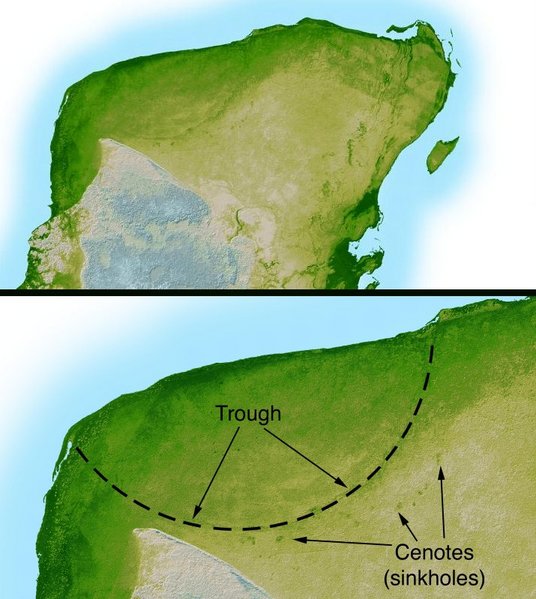The Chicxulub Crater
Chicxulub Crater is an ancient impact crater buried underneath the Yucatan peninsula, with its center located approximately underneath the town of Chicxulub, Yucatán, Mexico. Later investigations suggested that this impact structure is dated from the late Cretaceous, about 65 million years ago. The meteorite's estimated size is about 10 km (6 mi) in diameter, releasing an estimated 4.3×1023 joules of energy (equivalent to 191,793 gigatons of TNT) on impact.
The impact caused giant tsunamis in all directions. The emission of dust and particles caused environmental changes close to a nuclear winter, in which the surface of the Earth is totally covered by a cloud of dust for several years. This timing is in good agreement with the theory postulated by the physicist Luis Alvarez and his son Walter, a geologist, for the extinction of the dinosaurs. The Alvarezes postulated that the extinction of the dinosaurs, roughly contemporaneous with the K-T boundary, could have been caused by the impact of just such a large meteorite. This theory is now widely accepted by the scientific community.
The main evidence is a widespread, thin layer of iridium present in this geological boundary across the world. Iridium is a rare metal on Earth, but abundant in meteorites. It is thought that this impact event may have been partially or wholly responsible for the Cretaceous-Tertiary extinction event.
In early 1990, Alan K. Hildebrand, a graduate student at the University of Arizona, visited a small mountain village named Beloc in Haiti. He was investigating certain K-T deposits that include thick, jumbled deposits of coarse rock fragments, which were apparently scoured up from one location and deposited elsewhere by kilometers-high tsunami, giant sea waves, that most likely resulted from an Earth impact. Such deposits occur in many locations, but seem to be concentrated in the Caribbean basin.

Radar topography (color corresponds to height) of the Yucatán peninsula, revealing the Chicxulub Crater.
Hildebrand found a greenish brown colored clay with an excess of iridium, and containing shocked quartz grains and small beads of weathered glass that appeared to be tektites. He and his faculty adviser William V. Boynton published the results of the research in the scientific press, suggesting not only that the deposits were the result of an Earth impact, but that the impact couldn't have been more than 1,000 kilometers (620 miles) away.
This was particularly puzzling, because no crater of any size was known to exist in the Caribbean basin. Hildebrand and Boynton also reported their findings to an international geological conference, sparking substantial interest.
Evidence pointed to possible crater sites off the north coast of Colombia or near the western tip of Cuba. Then Carlos Byars, a reporter for the Houston Chronicle, contacted Hildebrand and told him that a geophysicist named Glen Penfield had discovered what might be the impact crater in 1978, buried under the northern Yucatan Peninsula.
In that year, Penfield had been working for Petroleos Mexicanos (PEMEX, the Mexican state-owned oil company), as a staff member for an airborne magnetic survey of the Yucatan peninsula. When Penfield examined the survey data, he found buried in the noisy data a huge underground "arc", with its ends pointing south, in the Caribbean off the Yucatan that was inconsistent with what he knew about the region's geology.
Penfield was intrigued, and managed to obtain a gravity map of the Yucatan that had been made in the 1960s and was gathering dust in PEMEX's archives. He found another arc, but this one was on the Yucatan itself, and its ends pointed north. He matched up the two maps and found that the two arcs joined up in a neat circle, 180 kilometers (112 miles) wide, with its center at the village of Puerto Chicxulub.
Penfield was an amateur astronomer and had a good idea of what he was looking at. Although PEMEX would not allow him to release specific data, the company did allow him and a PEMEX official named Antonio Camargo to present their results at a geological conference in 1981. Unfortunately, that particular conference was under-attended in that year, ironically because most geologists were attending a workshop on Earth impacts, and their report attracted very little attention, though it did get back to Byars.
Penfield didn't give up. He knew that PEMEX had drilled exploratory wells in the region in 1951. One of the wells had bored into a thick layer of igneous rock known as "andesite" about 1.3 kilometers (4/5ths of a mile) down. Such a structure could have resulted from the intense heat and pressures of an Earth impact, but at the time of the borings it had been written off as a "volcanic dome", even though such a feature was out of place in the geology of the region.
Further studies of the archived well cores would have resolved the issue, but unfortunately most of them had been destroyed in a warehouse fire in 1979. Penfield presently flew down to the Yucatan to see if he could find anything out from the "tailings" left by the wellheads. This idea didn't pan out, and in one case Penfield found himself digging through a communal pigsty that had been set up on a wellhead site, a task he described as "unpleasant and unrewarding".
After Hildebrand got in touch with Penfield, however, the two men were able to locate two separate samples from the wells drilled by PEMEX in 1951. Analysis of the samples clearly showed shock-metamorphic materials. Studies by other geologists of the debris found in Haiti at Beloc also showed it to be clearly the result of an impact.

Gravity map of the Chicxulub Crater, Mexico (after Hildebrand et al)
This research was persuasive, and received a major boost when a team of California researchers, including Kevin O. Pope, Adriana C. Ocampo, and Charles E. Duller, conducted a survey of satellite images of the region. They found that there was a nearly perfect ring of sinkholes centered on Puerto Chicxulub that matched the ring Penfield had found in his data. The sinkholes were likely caused by subsidence of the crater's wall.
This evidence was enough to get most of the geological community on the bandwagon, and further studies have reinforced the consensus. Indeed, some evidence has accumulated that the actual crater is 300 kilometers (186 miles) wide, and the 180 kilometer ring is just an inner wall.
In recent years, several other craters of around the same age as Chicxulub have been discovered, all between latitudes 20°N and 70°N. Examples include the Silverpit crater in the United Kingdom, and the Boltysh crater in Ukraine, both much smaller than Chicxulub but likely to have been caused by objects many tens of metres across striking the earth. This has led to the hypothesis that the Chicxulub impact may have been only one of several impacts that happened all at the same time.
The collision of Comet Shoemaker-Levy 9 with Jupiter in 1994 proved that gravitational interactions can fragment a comet, giving rise to many impacts over a period of a few days if the comet should collide with a planet. Comets frequently undergo gravitational interactions with the gas giants, and similar disruptions and collisions are very likely to have occurred in the past. This scenario may have occurred on Earth 65 million years ago.
All text is available under the terms of the GNU Free Documentation License.